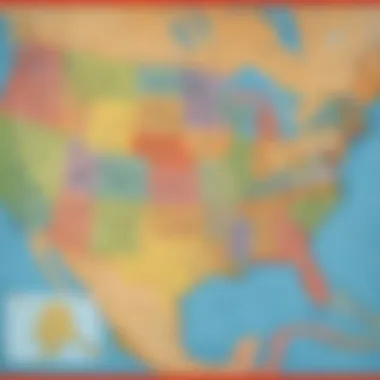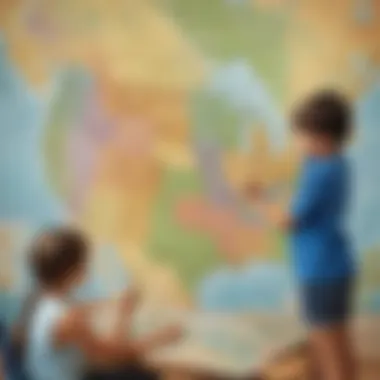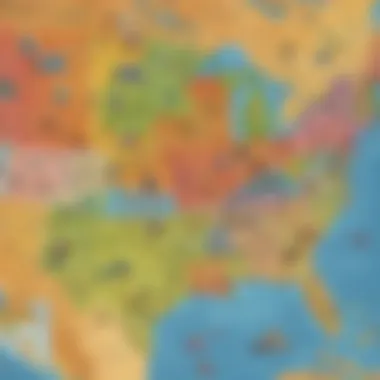Discovering America with Labeled Maps for Kids


Intro
When it comes to learning about geography, a labeled map of the United States can be a golden ticket. Picture this: children sitting around a table, their heads almost glued to a colorful map, excitedly pointing out states, capitals, and famous landmarks. This isn’t just play; it’s a dynamic approach to grasping the vastness and uniqueness of the country. Labeled maps serve not just as a tool, but as a foundation for educational exploration. They encourage critical thinking and a deeper understanding of the geographical landscape.
In this article, we’ll sift through the various types of labeled maps, understand their significance in education, and delve into engaging techniques to make geography not only informative but also fun. If you’re a parent, teacher, or caregiver, this guide will equip you with insights to enhance children’s learning journeys—turning what often seems dry and academic into something vibrant and alive.
Interactive Learning Games
Interactive learning games can light a spark in kids' curiosity about geography. These activities merge gameplay with learning, leading to an enriched educational experience. Here we’ll navigate through some popular games and their impact on children’s cognitive development.
Popular Games
Some games have climbed the popularity charts when it comes to geological learning. Here are a few:
- GeoGuessr: Tests spatial awareness and geographical knowledge by dropping players in random locations.
- Stack the States: Engages kids in memorizing state shapes, capitals, and trivia.
- Where in the USA is Carmen Sandiego?: Combines detective work with geography, requiring kids to follow clues to locate places.
Description of Top Educational Games
Each game brings its unique flavor to the table. For instance, Stack the States employs visuals of states that children can stack, reinforcing their shapes while keeping gameplay fun and competitive. GeoGuessr, on the other hand, pushes their observational skills to the limit, making them look beyond mere borders and into real-world contexts.
Benefits of Playing Educational Games for Kids' Cognitive Development
Playing these educational games can enhance cognitive skills in several ways:
- Critical Thinking: Players assess clues and make decisions.
- Problem-Solving: Many games present challenges that require creative solutions.
- Memory Retention: Engaging with the material often reinforces what they learn.
Game Reviews
Let’s take a closer look at a couple of games:
- Stack the States: This game has a fantastic interface that keeps kids intrigued. It makes the otherwise dry facts about states captivating and memorable.
- Where in the USA is Carmen Sandiego?: Not only does this game reinforce geographical knowledge, but it also spins a compelling story that keeps kids coming back for more action.
Comparison of Gameplay and Learning Outcomes
When comparing these games, it’s clear they offer various gameplay experiences, which leads to different learning outcomes. Stack the States is very visual and auditory, suited for various learning styles, while GeoGuessr promotes observational learning—a game of clues and deduction.
"Games like these serve as windows into different cultures and places, enriching children's perspectives and ideas about the world."
Educational Topics
While geography is crucial, it often intersects with various subjects such as math, science, and language arts. This brings us to interdisciplinary learning, which enhances children's overall knowledge landscape. Programs that incorporate labeled maps can tie into biology with ecosystems of different states, or delve into history with landmarks rooted in tales and events.
Tips and Tricks
Here are some useful tips for parents and educators.
- Integrate Maps into Daily Routine: Use labeled maps during family outings to explore geographical connections.
- Incorporate Storytelling: Share stories related to each state or capital, making them memorable.
- Hands-on Activities: Engage kids in DIY projects centered around maps to reinforce learning.
Creative DIY Projects
Hands-on projects can create a memorable touchpoint in learning. Here, we’ll explore step-by-step guides that encourage creativity while tying back to the core theme of geography through maps.
Step-by-Step Guides
One engaging project might be to create a fabric map. Gather materials like colored fabric pieces, a large base fabric, and glue. Kids can cut out shapes of each state, painting them or using fabric markers, and then stick them onto the larger canvas. This stimulates tactile learning and fine motor skills.
Craft Ideas
Another craft can be making a landmark collage. Using pictures collected from magazines or online, children can cut out images of famous landmarks across the U.S. and create their collage on a large poster. This visual representation strengthens their understanding of geography while encouraging artistic expression.
In today's rapidly evolving educational landscape, harnessing the power of labeled maps and related activities can transform how children perceive the world around them, marrying fun with important knowledge. This engagement not only shapes a more informed generation but also fosters a lasting curiosity that extends well past the classroom.
Prelude to Labeled United States Maps
Labeled maps of the United States serve a pivotal role in geographic education, making complex information more comprehensible and engaging for learners of all ages. They play a crucial part in the foundational understanding of geographic concepts and are instrumental in helping children recognize the geographical layout of their own country. Familiarity with states, capitals, and geographical landmarks is more than just rote memorization; it fosters a deeper appreciation of cultural, historical, and ecological aspects that shape the United States.
Geography, as a subject, often faces challenges in maintaining students' interest. However, annotated maps provide an effective way to bridge this gap. By turning abstract concepts into visual guides, these maps enable students to visualize relationships between different locations, recognize patterns, and understand socio-political contexts. Through a labeled approach, educators can stimulate curiosity, encouraging young learners to explore not only the places on the map but also the stories behind them.
Importance of Geography in Education
Geography is more than just a subject; it is a lens through which we can see the world around us. The study of geography in education brings several benefits:
- Critical Thinking Skills: Engaging with maps encourages analytical thinking. Learners can interpret data, identify trends, and ask important questions about the environment and society.
- Spatial Awareness: Understanding spatial relationships enhances learners’ awareness of their surroundings and inspires them to explore their communities.
- Cultural Understanding: Geography teaches students about diversity in humanity, promoting empathy and respect for different cultures and traditions.


As children connect places with historical events or environmental factors, they grasp how geography influences lives on a broader scale.
Overview of Labeled Maps
Labeled maps are detailed guides that present essential information clearly. They can come in various forms:
- Political Maps: These typically mark country boundaries, states, and capitals. They depict political divisions, which are crucial for understanding governance and political relations.
- Physical Maps: They emphasize natural features such as mountains, rivers, and lakes. Such maps can demonstrate the impact of these features on human activity and settlement patterns.
- Thematic Maps: These focus on specific subjects, such as population densities or climate zones, providing deeper insights into social and environmental issues.
In a nutshell, labeled maps are powerful tools that, when utilized effectively, can transform the way students perceive the world. As discussed, their importance spans across enhancing geographical knowledge, encouraging critical thinking, and instilling a sense of exploration among young learners.
"Maps are not only a representation of reality, but they also shape how we think about the world and our place within it."
Utilizing labeled maps in classrooms presents diverse opportunities to engage with the subject creatively. By blending traditional geography lessons with these engaging visual aids, educators can create a more dynamic and interactive learning environment.
Types of Labeled Maps
When one thinks about navigating the vastness of the United States, labeled maps stand out as indispensable tools. Maps not only help learners grasp locations better, they also promote spatial awareness. Each type of labeled map serves its unique purpose and brings an array of benefits to the table. Understanding these distinctions can enrich students’ geographical knowledge and make the learning process more engaging.
Political Maps
Political maps are like blueprints of human governance. They showcase the borders between states and countries and mark significant political entities like capitals and major cities. These maps can be crucial for students learning about governance, political systems, and history.
When utilizing political maps, learners engage with essential skills such as:
- Identifying locations: Knowing where a state or capital is situated makes it easier to comprehend its political dynamics.
- Understanding boundaries: This sharpens their awareness of topics such as international relations, state rights, and regional politics.
For instance, a map showing the political subdivisions of the United States can provide a quick snapshot for discussions about electoral processes or state governance. Teaching kids to locate their state's capital can spark a conversation about local leadership and civic responsibility.
Physical Maps
Then there are physical maps, which paint a different picture entirely. These maps delve into the natural features of the United States, illustrating elements like mountains, rivers, and lakes. They provide a concrete context for students to visualize the terrain of the country as well.
Being descriptive, physical maps allow learners to:
- Explore geography: Visual understanding of features like the Rocky Mountains or the Mississippi River enhances appreciation for natural beauty.
- Study ecosystems: Understand how various features influence climate and wildlife across regions.
Kids might find it fascinating to see how physical geography affects human settlement. Maps that show the Appalachian Mountains can lead to discussions about culture in various regions, illustrating how geography influences lifestyle and economy.
Thematic Maps
Lastly, thematic maps shine a spotlight on specific subjects or themes, which makes them versatile educational tools. From population density to climate zones, these maps help students analyze various factors that shape the United States.
Thematic maps can assist in:
- Drawing comparisons: For example, comparing population spread to resource availability encourages critical thinking.
- Visualizing data: These types of maps make statistics more relatable. Instead of reading numbers, kids can see the differences across states.
As an example, a thematic map illustrating where various crops are grown can spark a lively discussion on agriculture, trade, and even culinary diversity across the country.
"Understanding different types of labeled maps not only aids in geographic literacy but also fosters curiosity about the interactions between people and their environment."
In sum, each type of labeled map—political, physical, and thematic—offers distinct pathways for understanding the complex tapestry that makes up the United States. By engaging with these maps, learners can develop a well-rounded view that enriches their education and ignites a passion for exploration.
Components of a Labeled Map
Understanding the components of a labeled map is crucial for both learners and educators. Often, a labeled map serves as a visual tool that bridges abstract geographic concepts with tangible real-world applications. It's the nuts and bolts of map literacy that can deepen a child's appreciation of geography, enhancing their ability to navigate not just the physical landscape but also the cultural and historical layers that shape it.
States and Borders
One of the foundational features of a labeled map is, without a doubt, the delineation of states and borders. Each state stands like a piece of a complex puzzle, interlocking with its neighbors to create a broader picture of the United States. For children, learning how to identify and name the states simplifies a daunting task into manageable bits.
Why does this matter? Understanding state lines helps children grasp the concept of territory and governance. Knowing where one state ends and another begins can foster a sense of belonging or identity. It promotes discussions on why certain borders were drawn, which often leads to historical explorations of political decisions, conflicts, and treaties.
"Maps are not only geographical tools; they’re invitations to explore the stories behind each border and state."
Besides, exploring the borders can also instill a sense of curiosity. Kids might find it fascinating to learn about states that share borders, like Texas and Oklahoma, or the unique shape of Florida, which resembles a sandy peninsular finger reaching into the ocean.
Capitals and Major Cities
Next up are capitals and major cities. Every state has a capital that serves as its political nucleus. For youngsters, mastering the capitals can be a rite of passage in geography classes. But there’s more to it than just rote memorization; these capitals often embody the history, culture, and government of the state.
Children should be encouraged to explore not just the capitals, but the historical significance of cities such as New York City or San Francisco. For instance, New York has housed immigrants for decades, contributing to a melting pot of cultures. Understanding this background can elevate students' knowledge well beyond basic facts.
Here’s a small exercise:


- Name the capital of Texas: Austin
- Identify a major city in Illinois: Chicago
Such simple activities can evoke discussions about economic, social, and cultural impacts, pulling kids into the narrative and making geography a living, breathing subject.
Geographical Features
Lastly, we can’t overlook geographical features. Mountain ranges, rivers, lakes, and valleys form the backdrop against which the states and cities play their roles. These physical attributes can be fascinating not just because of their beauty but also because of their influence on human activity.
For example, understanding that the Great Lakes are not only vast bodies of water but also critical for trade and transportation can illuminate how geography shapes industry and settlement patterns. It's vital to let children connect the dots between these features and the lifestyle of the communities that surround them.
Incorporating geographical features into lessons allows for a richer exploration of how the land has influenced historical events, migration patterns, and even climate.
- Question for students: How does the Mississippi River impact the states it flows through?
Connecting students with these elements in a labeled map can transform a seemingly mundane lesson into an adventure filled with discovery. Thus, the components of a labeled map serve as building blocks for comprehensive geographic understanding.
Utilizing Labeled Maps in Learning
Incorporating labeled maps into the educational landscape offers a myriad of benefits. These maps serve not only as a foundation of geographical knowledge but also as tools that enhance critical thinking and engagement among learners. Labeled maps allow students to visualize connections, spot trends, and comprehend spatial relationships that might otherwise remain abstract. As learners interact with these resources, they develop a sense of place that can enrich their understanding of the world.
When it comes to the classroom or homeschooling environment, leveraging labeled maps encourages a more hands-on approach to education. Kids engage with geography in a dynamic manner when they draw lines on a map or piece together elements in a game format. Beyond rote memorization, labeled maps spark an interest that can lead to deeper exploration of local cultures, ecosystems, and histories. They are an invitation to discover hidden stories behind geographical landmarks, fostering not just knowledge but curiosity.
Interactive Learning Activities
Map Puzzles
Map puzzles represent a remarkable blend of education and play. Children can piece together the various components of the United States, from states to capitals, stimulating their problem-solving skills. The engaging nature of map puzzles makes them a fantastic option for interactive geography lessons. One strong characteristic of map puzzles is their ability to visually represent relationships between various geographical elements in an enjoyable way.
Unlike more passive forms of learning, map puzzles require kids to actively think about how pieces fit together. The tactile experience of handling physical puzzle pieces or using interactive apps can create lasting impressions. However, a disadvantage could be the initial challenge for some students in locating pieces correctly, which could cause frustration.
Labeling Exercises
Labeling exercises engage children in an active learning process by requiring them to identify and mark different geographical features on a map. This practice encourages retention of information. Students can label states, capitals, rivers, or mountain ranges, helping commit these facts to memory. The hands-on approach is a standout attribute, allowing learners to connect textual knowledge with visual representation.
Furthermore, these activities can serve varying educational needs, accommodating both visual and kinesthetic learners. On the flip side, some pupils may find these exercises monotonous if not presented creatively. It’s essential to mix up labeling exercises with other interactive activities to keep students intrigued.
Online Interactive Tools
Online interactive tools provide a modern twist to traditional map education. Websites and applications like Google Maps or specialized educational platforms allow students to explore regions virtually. These tools often include quizzes, flashcards, and games that challenge students to apply their knowledge actively. For instance, interactive maps might let students click on different states to learn fun facts.
Their key feature is accessibility, as these tools can be used anywhere with an internet connection. Students are exposed to current geographical data, making learning relevant and engaging. However, the reliance on technology can lead to some drawbacks, such as limited hands-on interaction compared to physical maps.
Incorporating Technology
Educational Apps
Educational apps designed for geography can make learning accessible and fun. These apps often use gamified learning to engage students, allowing them to explore different elements of map reading and geographic analysis. An essential hallmark of educational apps is their versatility; they cater to various learning styles and age groups, making them a valuable addition to any educational toolkit.
One unique feature is the immediate feedback mechanism present in many apps. This enables students to understand their mistakes promptly and learn from them. However, the drawback may include the requirement for devices, which can be a barrier for some families.
Virtual Mapping Tools
Virtual mapping tools like Google Earth present geography in a three-dimensional space. Such tools facilitate a more contextual understanding of geographical features, allowing students to navigate landscapes and cultural sites as if they were stepping outside. The immersive nature of virtual mapping tools creates a vivid learning environment that captures students' imaginations.
The opportunity for exploration is perhaps one of the most significant advantages of these tools. However, they may lack the straightforward approach of traditional methods, potentially overwhelming younger learners.
Geographic Information Systems
Geographic Information Systems (GIS) represent a sophisticated approach to map education. These systems allow learners to analyze spatial data, exploring how different geographical elements interact. The strong point of GIS is its analytical power, enabling students to assess real-world issues, such as urban development or environmental changes.
One unique feature of GIS is its capacity for layering data, which means students can visualize various data sets simultaneously. However, the complexity of these systems can pose challenges. Younger students might find the learning curve steep without adequate guidance, limiting their initial engagement.
Promoting Critical Thinking Through Geography
In today’s fast-paced world, encouraging children to engage critically with their surroundings is more important than ever. Labeled maps serve as an invaluable tool in fostering this critical thinking through geography. By dissecting various components of a map, students can develop a deeper understanding of how geographical factors influence social, economic, and political environments.
Encouraging Exploration
When children begin to explore labeled maps, they are not just memorizing state names or capital cities. Instead, they embark on a journey of discovery, where every point on the map represents a story waiting to be uncovered. It encourages kids to ask questions like, "Why is California known for its tech industry?" or "How do geographical features like rivers affect where people live?"
Here are some effective ways to promote exploration through maps:
- Field trips: Organizing trips to local landmarks can provide hands-on experiences that are hard to replicate in a classroom.
- Map scavenger hunts: This activity engages children with the map while encouraging them to identify certain features or locations.
- Cultural exploration projects: This approach allows kids to research different regions of the U.S. and present what makes each unique, promoting cross-cultural understanding.


Each of these activities not only teaches geographical skills but also enhances curiosity, prompting children to think beyond the surface.
Analyzing Geographic Data
The ability to analyze geographic data is a skill that extends far beyond the classroom. This skill helps children understand patterns and connect the dots between different types of information. For instance, they can learn how climate affects agricultural production in different regions of the United States.
Children can engage with geographic data through:
- Graphing statistics: By collecting data on different states – such as population density, economic activities, or climate – and converting it into graphs, students learn to interpret data visually.
- Utilizing online platforms: Websites like Encyclopedia Britannica or Wikipedia offer data-rich resources that can be turned into projects. This challenges students to discern what information is relevant and credible.
- Interactive discussions: In group settings, discussing trends observed on maps allows children to articulate their thoughts and learn from peers, promoting analytical dialogue.
Engaging in these activities cultivates a mindful approach to geography and helps children develop critical thinking skills they can apply well beyond school.
Education is not the learning of facts, but the training of the mind to think.
By pushing students to dig deeper into geographic data and encouraging exploration, we foster a new generation of learners who can approach complex issues with a deliberate and analytical mindset.
The Role of Parents and Educators
When it comes to teaching geography, especially through labeled maps, parents and educators play a crucial role. These individuals influence and shape a child's understanding of the world. They have the unique opportunity to foster curiosity and engagement with geography. Not only do they provide the materials needed for learning, but they also create an environment that encourages exploration of maps and geography. This support system is vital for children to connect various geographical concepts to real-life experiences.
Supporting Geography Education at Home
Parents can create a vibrant learning atmosphere at home that makes geography exciting and accessible. Here are several strategies that can be employed:
- Family Game Nights: Playing map-related games, like geography trivia or creating a scavenger hunt with a labeled map, makes learning fun.
- Explore Together: Plan family trips that include destinations significant to geography, such as national parks or historical landmarks. Children will appreciate how geography plays a role in their everyday life.
- Utilizing Technology: There are many educational apps designed to teach geography in an engaging way. These apps often feature interactive maps and quizzes that can make learning feel less like a chore and more like an adventure.
By integrating geography into daily activities and conversations, parents can help strengthen their children’s understanding of the subject.
Integrating Maps into Curriculum
For educators, integrating labeled maps into the curriculum is not just about teaching facts; it's about fostering a broader comprehension of geographical concepts. Here’s how to effectively incorporate maps into learning:
- Interactive Lessons: Use projectors or smart boards to display maps. This can help students visualize geographical content that they are learning.
- Project-Based Learning: Assign projects where students create their own maps based on historical events or ecological features of certain regions. This hands-on approach deepens understanding.
- Cross-Disciplinary Links: Geography can intersect with subjects like history or science. Educators can develop lessons that highlight these connections, showing students how maps are relevant in multiple contexts.
- Field Trips: Educational trips where students collect data or sketch maps of their observations can ground geographical concepts in real-world contexts.
Incorporating these strategies can aid in developing a richer and more engaging geography curriculum, ultimately encouraging critical thinking and exploration among students.
"Maps are not just tools; they're invitations to explore the stories of our world, bridging the gap between education and real-life experiences."
Thus, the collaboration of parents and educators becomes integral to cultivating a well-rounded and curious approach to geography. The efforts in teaching geography through labeled maps can significantly enhance a child’s appreciation and understanding of the world.
Challenges in Teaching Geography
Teaching geography can be a mixed bag of joy and challenges. While the subject is essential for understanding our surroundings, engaging students effectively is often a tall order. It’s crucial to notice these obstacles because they can directly impact how children perceive and understand the world around them. A well-rounded approach can steer enthusiasm towards geography, allowing learners to appreciate maps, their components, and their relevance in everyday life.
Overcoming Student Apathy
A major issue in geography education is student apathy. Many students view geography as a dull subject filled with rote memorization of state names or capitals, which can make them tune out. To rectify this, educators must tap into students' interests and connect them to geographical concepts. For instance, using local geography to spark discussions can make lessons more relatable and engaging.
- Interactive learning: Incorporating games or interactive maps can awaken interest. Students could participate in mapping activities that involve local landmarks or events.
- Real-world connections: Using current events can bridge the gap between textbook knowledge and the real world. For example, discussing environmental issues, like climate change, can show students geography's relevance in their lives.
- Artistic approaches: Assigning creative tasks such as drawing maps or designing their own cities can also foster engagement. This breaks the monotonous cycle of traditional studying and allows for creative expression.
Addressing Misconceptions
Misconceptions in geography can lead to misunderstanding the content deeply. Some students may think geographical knowledge is only about memorizing facts without context, which is far from the truth. It's key to clarify these views, as geography is not merely about locations—it's about how these locations influence culture, economy, and environment.
To address misconceptions:
- Contextual learning: Provide context during lessons. Instead of simply stating facts, teachers should explain why a place is significant and how it ties into larger narratives.
- Encouraging questions: Foster an environment where questioning is encouraged. Allowing students to ask "why" can help unearth their understanding and dig deeper into geographical concepts.
- Using diverse media: Implementing a variety of teaching materials—videos, documentaries, and maps from different cultures—can help demystify geographical topics.
"True understanding in geography comes when one sees the connections, not just the locations."
By focusing on overcoming apathy and addressing misconceptions, educators can create a more productive learning environment that equips students with a robust understanding of geography. As children develop their mapping skills, they become not only more knowledgeable but also more curious about the world around them.
Epilogue
Grasping the essence of labeled maps is crucial for both educational foundations and fostering a sense of wonder about the world. Their implementation in teaching opens up avenues for interactive engagement that traditional methods may not provide. When children delve into the colorful details of a labeled map, they are not just memorizing names and locations; they are connecting dots in their understanding of geography, history, and even culture.
Summarizing the Importance of Labeled Maps
Labeled maps serve as essential tools in classrooms and homes alike. They simplify complex geographical concepts and make learning more accessible for children. Here are some salient points regarding their importance:
- Visualization: Kids can see how states fit together, understand borders, or grasp the proximity of major cities.
- Contextual Learning: By identifying landmarks and geographical features on a labeled map, children can learn the significance of their locations. For instance, understanding why New Orleans is vital due to its position along the Mississippi River.
- Foundation for Critical Thinking: Maps encourage questions and curiosity. What mountains separate the states? Why do certain cities thrive while others fade?
- Cultural Awareness: Exploring maps can spark interest in different cultures and histories tied to various regions. Learning can become a narrative, making history feel real and relatable.
In sum, labeled maps transform abstract geographical facts into interactive learning experiences that help children build connections across various subjects.
The Future of Geographic Education
The educational landscape is evolving constantly, and the future of geographic education looks promising. Technology is steering the way forward, making geographical exploration even more interactive and engaging. Here’s what lies ahead:
- Increased Use of Augmented Reality: Imagine pointing a device at a traditional map, and seeing it come to life with 3D representations of landscapes and buildings. This could significantly enhance understanding and retention of geographical information.
- Integration with Global Issues: New curricula may focus on pressing global challenges like climate change or urbanization, using maps to explore their effects in real time. Students could learn about the impact of rising sea levels on coastal cities, for instance.
- Personalized Learning Experiences: With the rise of adaptive learning platforms, educational tools will likely tailor geography lessons to individual learning styles, making each child’s experience unique.
- Collaboration Across Borders: Online platforms will enable students from different regions to collaborate on map-related projects, sharing perspectives that enrich their understanding of global geography.
As we look ahead, these innovations hold the potential to make geography education more accessible, engaging, and relevant. By continuously adapting and leveraging new technologies, we can ensure that the importance of labeled maps and geographical education remains at the forefront of learning.















